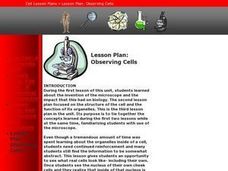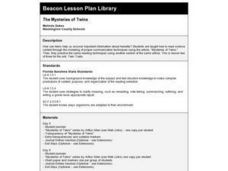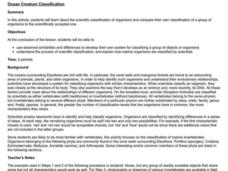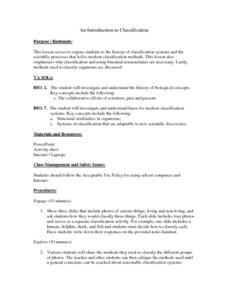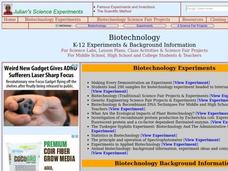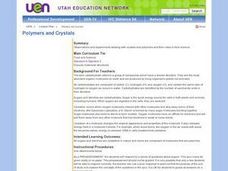Curated OER
What Can We Learn From the X Chromosome?
Students read about the X and Y chromosomes in humans and complete a worksheet.
Curated OER
The Mysteries of Twins
Third graders experience reading in the content areas by reading about heredity and practicing summarizing the reading.
Curated OER
Ocean Creature Classification
Students develop their own system for classifying a group of objects or organisms using observed similarities and differences. They investigate the process of scientific classification, and explain how marine organisms are classified by...
Curated OER
Ocean Creature Classification
Students develop a Taxonomic Key for marine invertebrates from pictures they are given after practicing together with common objects, such as shoes. They then compare their key to a provided Ocean Invertebrates Taxonomic Key.
Curated OER
An Introduction to Classification
Sixth graders explore, analyze and study the history of classification systems and the scientific processes that influenced modern classification methods. They evaluate why classification and binomial nomenclature are necessary to the...
Curated OER
X or Y- Does it Make a Difference?
Students examine the X and Y chromosomes. In this research lesson, students use the 5E lesson model as they read articles about human chromosomes then discuss their findings and opinions.
Curated OER
Biotechnology
Learners explore biotechnology through various activities. In this biology lesson, students analyze its pros and cons. They study and read informative articles about biotechnology.
Curated OER
The Meaning of Genetic Variation
Students investigate variation in the beta globin gene by identifying base changes that do and do not alter function, and by using several Internet-based resources to consider the significance in different environments of the base...
Curated OER
Proteins Expressed At Different Stages
Students investigate protein electrophoresis in a lab setting. Full laboratory equipment is needed and safety should be taught. The level of prior knowledge needed to perform lab is high and is ideal for an honors class.
Curated OER
Genetic Disorders
Seventh graders discuss traits, traits that are inherited and how genes and chromosomes carry the code for traits. They research genetic disorders and their link to chromosome abnormalites and write a report on their findings. which...
Curated OER
Blood Business
Students identify the different kinds of blood. In this biology lesson, students investigate the antigens, agglutinins and Rh factor using their own blood. They use Punnett squares to predict blood type of offspring.
Curated OER
What Happens When A Cell Divides?
Students investigate the cycle of mitosis. In this biology activity, students discuss the different stages of mitosis through cell reproduction. They further their investigation through laboratory analysis.
Curated OER
Polymers and Crystals
Young scholars experiment with crystals and polymers and examine their roles in food science.
Curated OER
Virus Tracker
Sixth graders will simulate the spread of a virus such as HIV through a population by "sharing" (but not drinking) the water in a plastic cup with several classmates. Although invisible, the water in a few of the cups will already be...
Curated OER
Cells and Cancer
Students idenitfy that cancer is a growth of mutated cells and that cancer cells are only one type of cell that causes disease in our body. They also identify that all eukaryotic cells contain a nucleus, cytoskeleton, and a cell...
Curated OER
Technology
Students recognize descriptions of different types of biotechnology currently being used. They form persuasive arguments for or against that particular type of biotechnology.
Curated OER
Viruses and Host Evolution
Young scholars research viruses and their effects on the evolution of a rabbit population. They complete a teacher created worksheet of questions on their research. They present their research to classmates.
PBS
Pbs Learning Media: Dna Structure and Function: Decoding Watson
Discover how the structure of DNA relates to its hereditary function in these videos from the American Masters film Decoding Watson. The first video, "DNA Structure and Function," [2:07] can be used with all middle and high school...
TeachEngineering
Teach Engineering: Imaging Dna Structure
Students are introduced to the latest imaging methods used to visualize molecular structures and the method of electrophoresis that is used to identify and compare genetic code (DNA). Students should already have basic knowledge of...
Howard Hughes Medical Institute
Hhmi: Bio Interactive: Dna: Teacher Guide
This curriculum guide assists in filtering through the vast available resources from BioInteractive and HHMI and organizes the material according to various topics related to DNA, including DNA structure, replication, and repair.
Alabama Learning Exchange
Alex: Dna Technology Project
Students will research current uses for DNA technology. Students identify a variety of ways that DNA technology can be used. Finally, the students create a DNA Technology project using technology. This lesson plan was created as a result...
Other popular searches
- Dna Structure and Function
- Structure of Dna
- Dna Structure Powerpoint
- Dna Structure Model
- Dna Structure Concept Map
- Dna Structure Worksheets
- Modeling Dna Structure
- Dna Structure Paper
- Dna Structure Animations
- Dna Structure Lesson Plans
- Dna Structure Base Pair
- Discovery of Dna Structure

